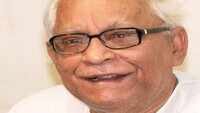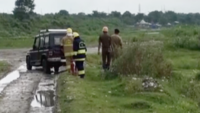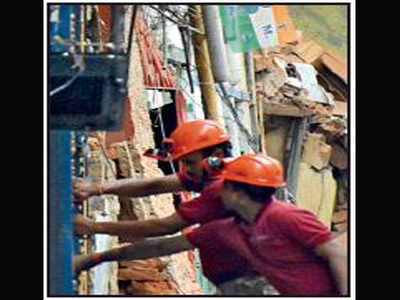
KOLKATA: Kolkata Metro Railway Corporation officials have noticed “fresh subsidence or soil settlement” along a section of the East-West Metro between the Hind Cinema crossing and Bowbazar, along Nirmal Chandra Street, where tunnelling has already been completed apparently without any hitch.
An 85-metre stretch to the southwest of Durga Pithuri Lane (the zone where the KMRC is struggling to contain the fallout of the August 31 underground accident) has subsided by 8 mm over the past three days. That, admit officials, is 10 times the maximum soil settlement along the stretches — including SN Banerjee Road and Government Place East — where tunnelling had been completed earlier.
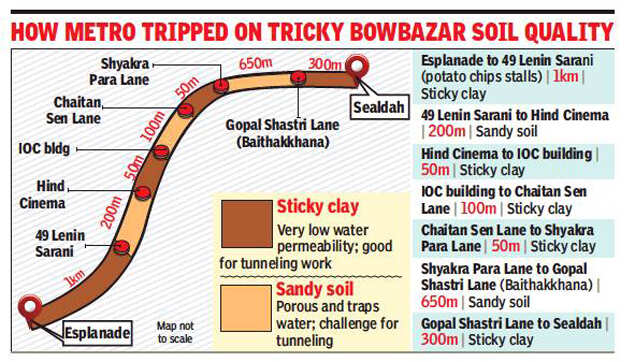
This has now prompted KMRC to plan a fresh survey of buildings along Nirmal Chandra Street to check for cracks that may have appeared over the past few days. TOI on Monday ran a front-page report on cracks discovered by residents and traders in buildings along this very stretch.
“We have managed to arrest subsidence around the north, east and west of Durga Pithuri Lane after extensive grouting since the underground aquifer was pierced accidentally on August 31. But, over the last few days, ground settlement has been noticed in the direction of Esplanade till around 85 metres from the subsidence epicentre,” a KMRC insider told TOI, adding that this was a “concern”.
Officials said the stability of buildings, under which the twin tunnel-boring machines Chundee and Urvi had traversed, would be checked. Chundee, which is boring the west-bound tunnel, has travelled 1.6 km; Urvi, which is boring a parallel tunnel for the line in the opposite direction, has traversed 1.2 km.
Topographically, the 2.45-km East-West Metro’s underground route from Esplanade to Sealdah is characterised alternately by sticky clay and sandy soil. The former is condusive to tunnel construction but the latter is not.
The TBMs that are boring the tunnel from Esplanade to Sealdah Station (east-ward direction) have already covered nearly half the journey. It is only after 49 Lenin Sarani, a three-storeyed building at the Lenin Sarani-Nirmal Chandra Street intersection that houses a couple of popular potato chips outlets, that the soil character changes more frequently.
“The soil is sticky clay up to Wellington Square; it that has no permeability and is, hence, compact and good to bore through. But, after that, the soil character changes to sandy; it is porous and allows water to trickle through and accumulate, leading to formation of shallow aquifers. Chundee negotiated one such sandy layer between Wellington Square and Hind Cinema. The soil was sticky clay again after that and it was a smooth run till it ran into the large aquifer under Durga Pithuri Lane that caused the unprecedented subsidence,” an official explained.
“Grouting is being done but it will not be effective until the water stops seeping. Hopefully, the water seepage has not caused too much instability for the structures located along Nirmal Chandra Street. But we can find that out only after a thorough survey. Thankfully, the degree of settlement is declining,” another engineer said.
The TBM that is driven by the earth pressure balance has stopped digging and is exerting its own weight of around 450 tonnes on the soil. This may be adding to the soil settlement towards Nirmal Chandra Street where the tunnel is still flooded with water that seeped in, say engineers.
The soil is the safest about 300 metres from the Sealdah Station complex and tunnelling will be a challenge till this point. TBM Chundee had already crossed 150 metres of sandy soil along the 431m of curve from Chaitan Sen Lane before it hit the aquifer and water started charging out at 11 to 15 cubic metres per hour, leading to a complete halt to work in the zone.
An 85-metre stretch to the southwest of Durga Pithuri Lane (the zone where the KMRC is struggling to contain the fallout of the August 31 underground accident) has subsided by 8 mm over the past three days. That, admit officials, is 10 times the maximum soil settlement along the stretches — including SN Banerjee Road and Government Place East — where tunnelling had been completed earlier.

This has now prompted KMRC to plan a fresh survey of buildings along Nirmal Chandra Street to check for cracks that may have appeared over the past few days. TOI on Monday ran a front-page report on cracks discovered by residents and traders in buildings along this very stretch.
“We have managed to arrest subsidence around the north, east and west of Durga Pithuri Lane after extensive grouting since the underground aquifer was pierced accidentally on August 31. But, over the last few days, ground settlement has been noticed in the direction of Esplanade till around 85 metres from the subsidence epicentre,” a KMRC insider told TOI, adding that this was a “concern”.
Officials said the stability of buildings, under which the twin tunnel-boring machines Chundee and Urvi had traversed, would be checked. Chundee, which is boring the west-bound tunnel, has travelled 1.6 km; Urvi, which is boring a parallel tunnel for the line in the opposite direction, has traversed 1.2 km.
Topographically, the 2.45-km East-West Metro’s underground route from Esplanade to Sealdah is characterised alternately by sticky clay and sandy soil. The former is condusive to tunnel construction but the latter is not.
The TBMs that are boring the tunnel from Esplanade to Sealdah Station (east-ward direction) have already covered nearly half the journey. It is only after 49 Lenin Sarani, a three-storeyed building at the Lenin Sarani-Nirmal Chandra Street intersection that houses a couple of popular potato chips outlets, that the soil character changes more frequently.
“The soil is sticky clay up to Wellington Square; it that has no permeability and is, hence, compact and good to bore through. But, after that, the soil character changes to sandy; it is porous and allows water to trickle through and accumulate, leading to formation of shallow aquifers. Chundee negotiated one such sandy layer between Wellington Square and Hind Cinema. The soil was sticky clay again after that and it was a smooth run till it ran into the large aquifer under Durga Pithuri Lane that caused the unprecedented subsidence,” an official explained.
“Grouting is being done but it will not be effective until the water stops seeping. Hopefully, the water seepage has not caused too much instability for the structures located along Nirmal Chandra Street. But we can find that out only after a thorough survey. Thankfully, the degree of settlement is declining,” another engineer said.
The TBM that is driven by the earth pressure balance has stopped digging and is exerting its own weight of around 450 tonnes on the soil. This may be adding to the soil settlement towards Nirmal Chandra Street where the tunnel is still flooded with water that seeped in, say engineers.
The soil is the safest about 300 metres from the Sealdah Station complex and tunnelling will be a challenge till this point. TBM Chundee had already crossed 150 metres of sandy soil along the 431m of curve from Chaitan Sen Lane before it hit the aquifer and water started charging out at 11 to 15 cubic metres per hour, leading to a complete halt to work in the zone.
Trending Topics
LATEST VIDEOS
City
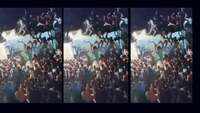 On cam: Several injured as roof collapses during Muharram celebrations in AP's Kurnool
On cam: Several injured as roof collapses during Muharram celebrations in AP's Kurnool  32-year-old man tries passing through security check-in area by impersonating as octogenarian passenger, held at Delhi Airport
32-year-old man tries passing through security check-in area by impersonating as octogenarian passenger, held at Delhi Airport 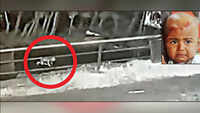 Kerala: One-year-old baby falls off speeding jeep, survives
Kerala: One-year-old baby falls off speeding jeep, survives 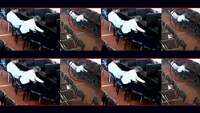 Scam in the name of exam: Now pan India recruitment scam exposed by Thane Police
Scam in the name of exam: Now pan India recruitment scam exposed by Thane Police
More from TOI
Navbharat Times
Featured Today in Travel
Quick Links
Lok Sabha Election Schedule 2019Lok Sabha Election NewsDelhi Capitals teamMI team 2019Rajasthan Royals 2019RCB team 2019Maharashtra Lok Sabha ConstituenciesBJP Candidate ListBJP List 2019 TamilnaduShiv Sena List 2019AP BJP List 2019Mamata BanerjeeBJP List 2019 MaharashtraPriyanka GandhiBJP List 2019 KarnatakaAMMK Candidate List 2019BJP List 2019 WBLok Sabha Elections in Tamil NaduBSP List 2019 UPNews in TamilLok Sabha Poll 2019Satta Matka 2018PM ModiMahagathbandhanNagpur BJP Candidate ListChandrababu NaiduTamil Nadu ElectionsUrmila MatondkarNews in TeluguMadras High CourtTejashwi YadavArvind KejriwalTejasvi SuryaPawan KalyanArvind KejriwalYogi AdityanathJaya PradaSatta King 2019Srinagar encounter
Get the app
